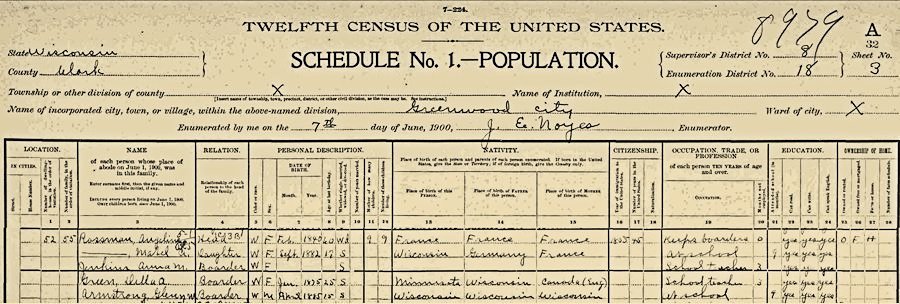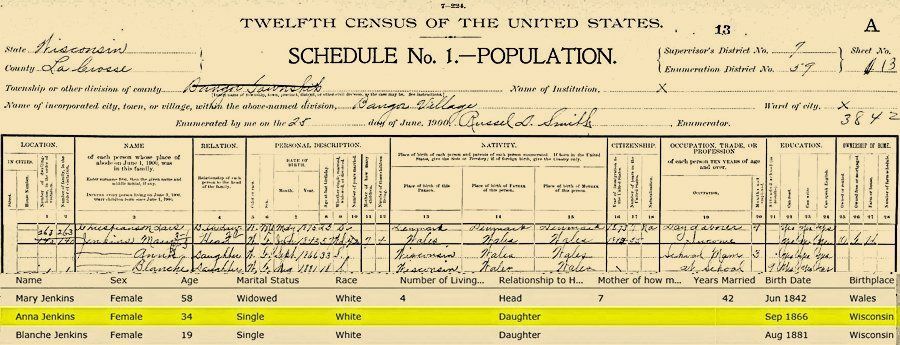Bio: Jenkins, Anna M. (Sep 1866-Oct 1933)
Transcriber: Janet
Surnames: Armstrong, Bodmer, Bossard, Buol, Chamberlin, Copling, Darling, Darms, Davis, Evans, Eynon, Garland, Green, Hatz, Hooper, Hussa, Jenkins, Johns, Jones, Mackenzie, Newton, Page, Reudebusch, Reudy, Rogers, Rossman, Sheydt, Steinberger, Wheldon, Williams, Wolf, Zimmerman
----Source: Census Records, New Postcard from the Steve Roberts collection. State Historical Society of Wisconsin / Wisconsin domesday book, Town studies Volume I (1924)
Anna M Jenkins
Sex Female
Age 65
Immigration Date 1931
Immigration Place San Francisco, California, United States
Birth Year (Estimated) 1866
Birthplace West Salem, Wisc
Anna Jenkins was boarding in the home of Angeline Rossman when the Federal Census was taken in June, 1900.
1900 Federal Census, Greenwood, Clark, WI, 7 June

Household
Angeline Rossman, 60 Head
Mabel A Rossman, 17 Daughter
Anna M Jenkins Boarder-Teacher
Della A Green, 25 Boarder
Glenn M Armstrong, 15 Boarder
----Source: Greenwood Gleaner, Greenwood, Wisconsin 9-7-1900
Mrs. Angeline Rossman is back from a couple of weeks’ stay on the farm with her son, Adolph, while his wife was visiting in Chicago. She has rented her house to Dr. Barber and in a few days will leave for Superior to make her home for the present with L. A. Rossman. Mabel is attending Normal there. John Rossman of Duluth, is here helping his mother get ready to move.
1900 Federal Census, Bangor Village, La Crosse, Wisconsin, 25 June

Household
Mary Jenkins, 57 Head (Jun 1842)
Anna Jenkins 33 Daughter (Sep 1866)
Blanche Jenkins 18 Daughter (Aug 1881)
2 Sep 1908 Postcard sent from Mabel to Anna Jenkins in Bangor, WI (see card #2--"The Greenwood, Wis. Power Dam"
Wausau pilot, October 25, 1910--Miss Anna Jenkins was called home last week by the illness of her mother.
1910 Wausau, WI Directory & 1913 LaCrosse, WI Directory

Wausau pilot, Jun 11, 1912--Miss Anna Jenkins who has been a teacher in our public school, for the past eleven years and most of that time principal of the Washington School, departed this morning for her home in Bangor, Wis. She is not to return to Wausau, much to the regret of her hosts of friends; on account of the ill health of her mother she feels tha tshe must be nearer her home. She will therefore teach in La Crosse next year. In Miss Jenkins Wausau loses one of its ablest and very highly esteemed teachers.
Wausau pilot, October 29, 1912--Miss Anna Jenkins of Bangor, Wis., a former teacher in our city schools, was here to attend the funeral of Winfield Jones.
14 Augl 1914 Postcard sent from Greenwood to Anna Jenkins living in Bangor, WI.
SS Sierra, Voyage #32, Sailing from Honoulu Hawaii 3 Dec 1931 to the Port of San Fransico. CA with arrival 9 Dec 1931.

***************************************************************************
Obit: Jenkins, Anna M. (1866-1933)
Anna M Jenkins 1866- 1933 (aged 66–67)
Cemetery: Fairview Cemetery, Bangor, La Crosse County, Wisconsin, USA
Plot Section: 017 Lot: 011 Gravesite: 006
Parents: Timothy Jenkins (1837, Wales–22 Jul 1882); Mary Jones Jenkins (16 Nov
1842, Cardiganshire, Wales, United Kingdom–1925)
Siblings: Eleanor Jenkins Page (20 Jan 1862, Bangor, WI–20 Dec 1912); John C.
Jenkins (1870, WI–1871, WI); Lloyd Timothy Jenkins (21 Dec 1878, Bangor, WI–19
Dec 1965); Harriet Blanche Jenkins (19 Augl 1881, West Salem, WI-1948)
***************************************************************************
In 1924, Anna M. Jenkins Wrote this about her hometown
SOCIAL HISTORY OF BANGOR ANNA M. JENKINS
(David J. Jenkins was her grandfather)
Bangor was first brought under town government as a part of the town of Pierce in 1852. Sections were withdrawn for the organization of different townships until 1856, when its individual organization was effected. It is located in the eastern part of the county and is unsurpassed for the fertility of its well watered and well wooded valleys, such as Dutch Creek, Fish Creek, and The Prairie. Nestling back from these broader valleys are many narrower ones fittingly designated as "coulees" by our own Hamlin Garland.
Early in the history of the state, companies of men looking about for a suitable place in which to begin a home saw these valleys and found them good to look upon. Here they decided to locate and build the home altar to which they could bring their families. Several distinct classes of settlers were among those who found homes in this fair domain-people from the East who were anxious to locate in more sparsely settled regions, natives of Switzerland who immigrated here from Sauk County and directly from Switzerland as well, sturdy Bohemians who had heard of the "promised land" of opportunity and had come to make their homes here, stalwart Norwegians locating in the deepest coulees because of the homelike appearance of the steep hillsides, and the idealistic Welshmen from the rugged slopes of Wales. Each group built for itself its own type of civilization and drew unto itself all those of like ideas. Today those different types of civilization are blended and merged into a distinctively American town.
Among the Swiss settlers we find such names as Bosshard, Reudy, Wolf, Darms, and Zimmerman. Bosshard and Reudy settled south of the present site of the village of Bangor in the Dutch Creek valley, and Zimmerman and Darms located claims two and one-half miles east of the village. These settlers brought with them the sturdy honesty and thrift of their forbears in Switzerland, and with them, too, they brought the love of freedom which courses through the veins of every true son of Switzerland. Their industry and thrift made their broad acres blossom as the rose, and today the farms which they developed are pointed out with pride by the descendants of these first settlers. A number of the farms are now owned by the third generation of the family that filed the claim. Later other Swiss families, attracted by the reports of their friends and relatives, came here and located in various parts of the township. Christian and Jacob Hatz, brothers, located on farms in Dutch Creek valley, and their sons, both named John, are prominent in the government of the town and the county.
The first white child born in the township was John Bosshard, son of the original first settler Bosshard. His son, John Bosshard, Jr., is now one of the progressive business men of the village and has served as village president. He tells an incident in the life of his father which pictures the handicaps of pioneer life. In those days bands of Indians roamed about and camped in convenient places on the banks of creeks. One day Baby John was missing. His mother searched for him in his usual haunts, but he was not to be found. Finally the thought of the Indian camp occurred to them, and there they found him. He had strayed out of his mother's sight, and the Indians had picked him up and taken him with them. Otto Bosshard, a brother of John, is a prominent attorney at La Crosse, has served the state as senator at Madison, and in political circles has won for himself an enviable reputation for sterling worth and unswerving loyalty to the state's best interests. These Swiss settlers organized a Freethinkers' association which was known as the Concordia Society. This society held a prominent place in the social life of the community for many years, and is still in existence. Concordia Hall, which was dedicated to the use of the society, still stands and is in good repair. The society had its physical training department, the Turners, its musical and dramatic department, and a school in which German and English were taught. The first teacher was a Mr. Copling; later Mr. Steinberger, a scholarly man and a Freethinker, taught the school for many years. Some of his descendants, the Reudebusch family, now live at Mayville, Wisconsin.
Joseph Hussa, a Bohemian, came to Bangor between 1858 and 1860, and built a brewery. After his death his sons carried on his business under the name of the Hussa Brewing Company. After the eighteenth amendment was passed the Hussa Brewing Company became the Hussa Canning Company, and the plant is doing a big business and furnishing work for many people.
Numbers of early Welsh settlers came from the East and others came directly from Wales, settling in what is now the village of Bangor and vicinity and in the Fish Creek valley. William Price bought the claim of Darms, who had settled east of the village, and John Williams bought the claim of C. Buol, who moved to Dutch Creek valley and later located west of the town of Bangor in Hamilton, where the Buol brothers now own acres and acres of the richest farm lands of the county.
John Wheldon was the first settler of the village, locating on a farm upon which, one year later, was laid out the village of Bangor. Later, other additions were made to the village. In casting about for a name for the little settlement, John Wheldon, filled with his love for "Hen Wlad Fy Nhadau" (old land of my fathers), which is every true Welshman's heritage, suggested the name Bangor, and it was at once adopted for town and village alike. The Wheldons, through their efforts, had the first post office opened at Bangor; it was kept in John Wheldon's log house--the first one in the village. Richard Wheldon, John's youngest brother, was the first postmaster. Later, John Wheldon served as postmaster. It was necessary to have the mail brought across the river from Burns, as the stage route was on the north side of the river. It has been said that the citizens of Bangor made an earnest effort to have the Chicago, Milwaukee, and St. Paul Railroad locate on the north side of the river, but fortunately for them their efforts were of no avail. The old Wheldon homestead, with beautiful modern buildings, is now owned by Robert and Griffith Wheldon, sons of John, the founder of the village of Bangor.
The second house in the village, also of logs, was built by David J. Jenkins, who arrived in the fall of 1853 (1827-1899). In 1854 he and John Wheldon built the flour mill on Dutch Creek, which he ran until 1870. After several changes in proprietors the mill came into the possession of John Bosshard and remained so until Jun 11, 1899, when the modest little Dutch Creek rose in its wrath and by a mighty flood washed away the mill and even the site. Both D. J. Jenkins and John Wheldon took an active part in the government of the little hamlet, both in turn holding the offices of town superintendent of schools, clerk, and justice of the peace. Jenkins in his capacity of justice performed many a marriage ceremony, his smallest fee being a half-bushel of turnips. As town superintendent of schools, so the story runs, he had a unique way of determining the qualifications of a teacher. A young man, a candidate for the necessary credentials for teaching, was told to come to the mill office. He promptly did so and spent the afternoon visiting with the genial proprietor of the mill, without, however, any reference being made to the object of his visit. When the young man was about to leave, Mr. Jenkins said, "Well, you'll do all right." The young fellow proved to be a very successful teacher. Such a primitive method of determining the fitness of a candidate is a far cry from the methods of the present day, when the pendulum has swung away from native intelligence and ability to diplomas, certificates, and degrees. When the office of supervising teacher of rural schools was created in the state, the position in La Crosse County was filled by Anna M. Jenkins, a niece of D. J. Jenkins; another niece, Mrs. Blanche J. Chamberlin, is the present county superintendent of schools-the first woman to hold that position in La Crosse County. Evan Jones, with a family of four sturdy sons, came to the town in 1852 and settled on a claim just west of where the village now stands. This property has never left the family and is now owned by two of his grandsons.
The Welsh people are naturally religious, and early in the history of the village a Welsh Congregational church was founded. This church was the scene of many a soul stirring "Eisteddfod," festival of song and poetry. This festival attracted the Welsh people from all parts of the county, many of them coming in wagons drawn by ox teams. The rafters of the church rang with the volume of sound that poured from the throats of these Welshmen, born with a natural gift of song. Evan L. Evans, John R. Jones, Edward R. Jones, Evan Jenkins, Thomas Eynon, John Jones (Dr. Jones), David Jones (commonly known as Singer Jones, in order to preserve his identity among so many of the same name), John Davis, David Johns, and many others were among the Welsh settlers who settled in the Fish Creek valley and transplanted a bit of Wales among the hills of La Crosse County. Many of their descendants live upon the farms developed by their ancestors. Dr. Owen Evans, a practicing physician of the village of Bangor, is a son of Evan L. Evans, and another son, Oswald, is postmaster of the village of Rockland in an adjoining township. John Jones, known as Dr. Jones because of his power as a healer of broken bones, handed down his gift to his son, William Jones, who for many years alleviated the sufferings of the afflicted with his oils and ointments. His son, in turn, Dr. Walter Jones, fully equipped with the best training available at home and abroad, brave with degrees and diplomas and possessed of the family gift of healing, is winning for himself fame and fortune in the city of La Crosse.
For a time the Welsh of Fish Creek worshiped with the Bangor Welsh, but later built a Congregational church of their own in Fish Creek. Later a company withdrew from this church and founded the Welsh Presbyterian church, which still holds occasional preaching services. It has been said that the church bells of Fish Creek rang "John Jones, John Evans, John Williams," but today there are many new settlers in the valley who could not respond to such a summons.
Among the eastern people who settled in the village and town were the Darlings, Elijah Hooper, Arthur Page, and C. W. Mackenzie. Arthur Page bought a farm in Dutch Creek, and two of his sons, Waldo and Willis, have a grain elevator and warehouse in the village. C. W. Mackenzie settled on a claim in 1858, and in 1854 brought his family to the home which he had built. One of his daughters married Dr. A. B. Newton, the first practicing physician of the village, and his granddaughter Cordelia, Mrs. Grant Rogers, now owns the beautiful farm home which with foresight her grandfather chose from all the acres about him, because of the charming site for a dwelling place. Mrs. A. B. Newton and Emma Mackenzie still live in the village. Abner Darling located in 1855 on a farm in Dutch Creek, and lived there until 1876, when he came to Bangor and became the proprietor of the Bangor House, the second hotel in the village. The first hotel was the Eagle Hotel, run by Henry Johns.
The Bangor Woolen Mills were built and owned by John Sheydt and John Reudy, and for many years did a thriving business. Later Sheydt sold his interest to Otto Bodmer, and the firm kept the name Bodmer and Reudy after Reudy's death.
From these beginnings-and the persons mentioned are only a part of those who settled in the town and village-has come the present town of Bangor with the incorporated village of the same name. The pretentious, comfortable homes, well tilled fields, and sleek herds of blooded cattle testify to the richness of the soil of the farms and to the prosperity of the farmers. As a result of this prosperity, schools and churches are maintained, and from the six one-room schools of the town come the recruits for the high school which has been established at Bangor village.
The village now has a population of nearly a thousand people. The high school building with its new gymnasium, erected at a cost of approximately $15,000, is the pride of the village and helps in the training of an ever increasing number of young people who are coming to realize that a high school education is the birthright of every American girl and boy.
There are four churches in the village-the Catholic, Lutheran, Presbyterian, and Baptist. Both town and village are largely Protestant, the Catholic church here being of comparatively recent origin in the town. All churches are in a thriving condition. The industries of the village are such as will best minister to the needs of the surrounding farming districts. The Hussa Canning Company last year had an output of between 115,000 and 125,000 cases of peas, pickles, and sauerkraut, using about two and three-fourths million cans. Their acreage for the coming year is in the neighborhood of 1130 acres.
The village is equipped with electric lights and a fine sewerage system. Two railroads-the Chicago, Milwaukee and St. Paul, and the Chicago and Northwestern-run through the village, making it really a suburb of La Crosse. These facts make of Bangor a very desirable location, and there are rarely empty houses in.0the village.
|
© Every submission is protected by the Digital Millennium Copyright Act of 1998.
Show your appreciation of this freely provided information by not copying it to any other site without our permission.
Become a Clark County History Buff
|
|
A site created and
maintained by the Clark County History Buffs
Webmasters: Leon Konieczny, Tanya Paschke, Janet & Stan Schwarze, James W. Sternitzky,
|
